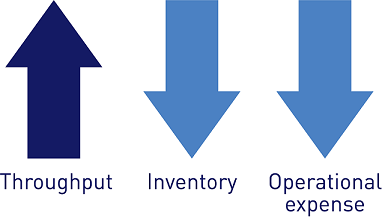If you read my previous post about “The Goal”, you already know who Alex Rogo is. Alex achieves the almost impossible feat of turning around his failing production plant and making it the most profitable operation in the company. For this, he uses the Theory of Constraints (TOC), following five steps of continuous improvement. Even more interesting, he determines these five steps by analyzing an event (hiking with his son’s scout troop) that is completely unrelated to a production process.
While reading “The Goal”, I make more connections between the book’s key lessons and what we put into practice here at DELMIA Quintiq. For example:
Supply chain planning and optimization software should be driven by relevant KPIs.
Initially, Alex struggles to arrive at a good plan of action. Not because he lacks vision, but because he has been focusing on the wrong performance metrics for too long. In a production environment, it is hard to connect the dots between net profit, ROI, cash flow (Alex’s focus measurements) and concrete operational actions. His first realization is that in order to improve the plant’s performance, he needs new relevant metrics and KPIs.
Next, he translates the financial metrics into three measurements applicable to production: throughput, inventory and operational expense. He realizes that as long as throughput increases while inventory and operational costs decrease, the production plant will be profitable.

At DELMIA Quintiq, we start all of our projects by defining the most relevant (to the customer’s business goals) KPIs. We hold several KPI sessions to drill down to precisely what the customer is trying to achieve. We then translate these expectations into concrete and pertinent measurements, so that all future planning decisions can be assessed through these metrics. You can read more about having the right KPIs in place from our COO, Arjen Heeres.
“We are reacting rather than planning”
In the last pages of the book, Alex faces the problem of “moving bottlenecks”. Even though he implements TOC successfully, what becomes apparent to him is the following: Once a corrective action is taken, its consequences are hard to predict and sooner or later it causes a complication elsewhere in the production system. “The Goal” was written in the mid-80s, so for Alex it would have been impossible to easily find the “remedy” for this problem.
If Alex had had DELMIA Quintiq’s scenario planning capabilities, it would have been quite a different story.
With the help of an intelligent planning and optimization platform, Alex could have performed “what-If” analyses utilizing different scenarios. He could have easily seen the consequences of increasing a bottleneck’s capacity and come up with remedial action that would eliminate the problem. Scenario planning drives better decision making not only for short-term actions but also for strategic long-term processes. Learn more about the importance of scenario planning from my colleague, Ilka Schulte.
Got a comment? Let us know or drop us a tweet @Quintiq.
Reference: Goldratt E., Cox, J. (2010), The Goal: Third Edition, Gower Publishing: Burlington, USA
